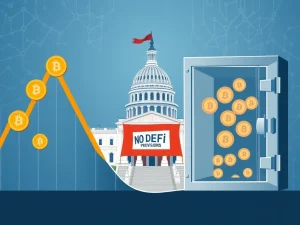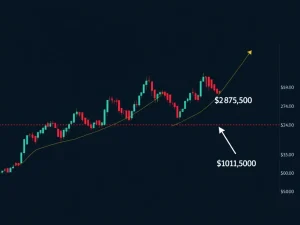Stablecoins: Coinbase Decisively Debunks Bank Deposit Drain Myth

Are stablecoins a threat to traditional finance? Coinbase unequivocally says no. The leading crypto exchange recently challenged the prevailing narrative that these digital assets are draining bank deposits. Instead, Coinbase argues that stablecoins bolster the US dollar’s global standing. This perspective directly counters fears of deposit erosion within the banking system. It also sheds light on the actual economic impact of stablecoins, particularly their role as efficient payment tools. For anyone tracking the intersection of cryptocurrency and traditional finance, this debate holds significant weight.
Coinbase’s Core Argument: Stablecoins as Payment Tools
Coinbase has strongly pushed back against the notion that stablecoins pose a significant threat to traditional banking. The company labels the idea of “deposit erosion” a baseless myth. In a recent blog post, Coinbase presented its detailed arguments. They emphasized that fears surrounding stablecoins draining bank deposits are largely unfounded. Furthermore, recent analysis by Coinbase indicates no meaningful link exists between stablecoin adoption and deposit outflows at community banks. This data challenges common misconceptions.
Crucially, Coinbase clarifies the function of stablecoins. They are not savings accounts; rather, they serve as advanced payment tools. “Stablecoins don’t threaten lending—they offer a competitive alternative to banks’ $187 billion annual swipe-fee windfall,” the exchange stated. This highlights their efficiency. For example, someone purchasing stablecoins to pay an overseas supplier is not reallocating savings. They are simply choosing a faster and cheaper payment method. This distinction is vital for understanding their economic role.
Challenging Treasury Projections and Misconceptions
Coinbase also directly addressed a recent US Treasury Borrowing Advisory Committee report. This report projected a potential $6 trillion in deposit flight. However, it only forecasted a $2 trillion stablecoin market by 2028. Coinbase found this discrepancy significant. “The math doesn’t add up,” the exchange claimed. This assertion underscores a perceived disconnect between official projections and market realities.
The company’s analysis suggests an overestimation of stablecoins’ domestic impact. This further supports their argument that these digital assets are misunderstood. The focus often shifts to their potential risks, overshadowing their practical utility. Thus, Coinbase aims to correct this narrative. They advocate for a more accurate understanding of stablecoins’ economic footprint.
Global Reach and Boosting Dollar Dominance
A key part of Coinbase’s argument centers on the international nature of stablecoins. In an accompanying paper, Coinbase detailed that most stablecoin activity happens outside the United States. This is especially true in regions with less developed financial infrastructure. The International Monetary Fund (IMF) supports this view. The IMF reported that over $1 trillion of the $2 trillion stablecoin transactions in 2024 occurred beyond US borders. Asia, Latin America, and Africa are notable hotspots for this activity.
Since nearly all major stablecoins are pegged to the US dollar, their widespread use abroad has a significant effect. It reinforces dollar dominance globally. This means stablecoins expand the dollar’s international influence. They do so without significantly impacting domestic credit availability. Therefore, stablecoins are not eroding US deposits. Instead, they act as a digital conduit for the dollar’s strength on the world stage. This perspective reframes the entire debate.
Harmonizing Stablecoins with Traditional Banking
Coinbase believes that stablecoins and traditional banks can indeed thrive together. The company pointed to positive correlations between bank stock performance and crypto firms like Coinbase and Circle. These correlations emerged after the passage of the Guiding and Establishing National Innovation for US Stablecoins Act (GENIUS Act). This data suggests a potential for synergy, not conflict. The GENIUS Act aims to provide a clear regulatory framework for stablecoins. This framework could foster greater integration and cooperation.
This positive correlation is a critical data point. It challenges the zero-sum game mentality often applied to crypto and traditional finance. It shows that robust crypto regulation can lead to mutual benefits. Banks can potentially leverage stablecoin technology for faster, cheaper international payments. Meanwhile, stablecoin issuers can gain legitimacy and broader adoption. This symbiotic relationship could reshape financial services.
Critiques from the Banking Sector and the Need for Innovation
The banking industry has expressed concerns about stablecoin competition. Last week, Bitwise’s investment chief Matt Hougan criticized US banks for these complaints. He argued banks should focus on improving their offerings. Specifically, he highlighted the need for better interest rates for depositors. Hougan believes banks have long exploited depositors with low yields. Now, they are reacting defensively as stablecoins offer more competitive alternatives. This perspective underscores a demand for innovation within traditional finance.
In August, several US banking groups, led by the Bank Policy Institute, urged Congress to address a perceived loophole. They focused on the GENIUS Act. This loophole, they argued, might allow stablecoin issuers to offer yields indirectly. These offers could come through crypto exchanges or affiliates. Such a mechanism, banks claim, could circumvent existing financial regulations. This move reflects ongoing tension and lobbying efforts in the regulatory landscape.
The Debate Over Crypto Regulation and Future Outlook
The proposal from banking groups sparked immediate pushback. The Crypto Council for Innovation and the Blockchain Association asked US lawmakers to reject these revisions. They warned that the proposed changes would unfairly favor traditional banks. Such actions, they argued, would stifle innovation within the digital asset space. This highlights the contentious nature of crypto regulation. It is a constant battle between established players and emerging technologies.
The future of stablecoins depends heavily on the regulatory environment. Clear and balanced regulation can unlock their full potential. This includes enhancing global payment systems and strengthening dollar dominance. Conversely, overly restrictive rules could hinder progress. The ongoing dialogue between policymakers, banks, and crypto firms is crucial. It will shape how stablecoins integrate into the broader financial ecosystem. This evolving landscape promises both challenges and opportunities for all stakeholders.
Conclusion: Stablecoins Reshaping Global Payments, Not Draining Banks
Coinbase’s assertive stance reframes the conversation around stablecoins and their impact on bank deposits. The evidence suggests that stablecoins are not a drain on domestic banking but rather a powerful force for global financial innovation. They offer a faster, cheaper alternative for payments, especially internationally. This strengthens the US dollar’s position worldwide, rather than weakening it domestically. The debate also highlights the ongoing need for traditional banks to adapt and innovate their offerings. As crypto regulation evolves, the synergy between digital assets and traditional finance could lead to a more efficient and inclusive global financial system. The “myth” of stablecoins as bank destroyers appears to be just that—a myth, according to Coinbase.






